Analysis of CO2 Absorption in Gas/Liquid Membrane Contactors with Inserted Descending Hydraulic Diameters of 3D-Printed Turbulence Promoters
Abstract
1. Introduction
2. Membrane Absorption Apparatus and Materials
3. Theory and Analysis
3.1. Mass Transfer
3.2. Mathematical Formulations
3.3. Power Consumption Increment
4. Results and Discussions
4.1. Absorption Flux Improvement by Inserting 3D-Printed Turbulence Promoters
4.2. CO2 Absorption Flux Improvement by Embedding Various Turbulence Promoters
4.3. Energy Consumption Increment
5. Conclusions
- Inserting 3D-printed diamond turbulence promoters into the MEA feed stream results in relative increases in absorption flux, with a maximum improvement of 79.12% under a descending array configuration compared to the module using an empty channel.
- The results demonstrate that promoter-filled channels with descending promoter widths in membrane absorption modules achieve a more pronounced absorption flux improvement due to a larger driving-force concentration gradient.
- The study shows a higher absorption flux improvement in modules with uniform mini-promoter-filled channels compared to those with descending promoter-filled channels and uniform big-promoter-filled channels. However, the ratio of for descending promoter-filled channels follows a reverse order.
- Embedding promoter-filled channels with descending promoter widths into the MEA flow channel results in absorption flux improvement of up to 79.12% under a 40% inlet CO2 feed concentration and a 2.5 cm3/s MEA feed flow rate.
Supplementary Materials
Author Contributions
Funding
Institutional Review Board Statement
Data Availability Statement
Acknowledgments
Conflicts of Interest
Nomenclature
| Concentration (mol m−3) | |
| Mean value of (mol m−3) | |
| Membrane coefficient based on the Knudsen diffusion model (mol m−2 pa−1 s−1) | |
| Membrane coefficient based on the molecular diffusion model (kg m−2 Pa−1 s−1) | |
| Membrane permeation coefficient (mol m−2 pa−1 s−1) | |
| Diffusion coefficient of CO2 in gas feed stream (m2 s−1) | |
| Diffusion coefficient of CO2 in MEA absorbent feed stream (m2 s−1) | |
| Channel thickness (m) | |
| Equivalent hydraulic diameter of channel (m), | |
| Deviation of experimental results from the theoretical predictions | |
| Further absorption flux enhancement | |
| Fanning friction factor | |
| Dimensionless Henry’s constant | |
| Hydraulic dissipate energy (J kg−1), | |
| Absorption flux improvement | |
| Power consumption relative index | |
| Mass transfer coefficient in the CO2/N2 gas feed stream (m s−1) | |
| Mass transfer coefficient in the MEA absorbent feed stream (m s−1) | |
| Equilibrium constant | |
| Reduced equilibrium constant | |
| Overall mass transfer coefficient of membrane (m s−1) | |
| Friction loss (J kg−1), | |
| Channel length () | |
| Average molecular weight of CO2 and N2 gas mixture () | |
| Number of experimental measurements | |
| Saturation vapor pressure in the gas feed flow side () | |
| Saturation vapor pressure in the liquid absorbent flow side () | |
| Volumetric flow rate of the gas feed stream () | |
| Volumetric flow rate of the MEA absorbent stream () | |
| Gas constant (8.314 ) | |
| Reynolds number | |
| Precision index of an experimental measurements of absorption flux (mol m−2 s−1) | |
| Mean value of (mol m−2 s−1) | |
| Dimensionless Schmidt number | |
| Enhanced dimensionless Sherwood number | |
| Dimensionless Sherwood number for laminar flow | |
| Spiral-ring pitch width (m) | |
| Ratio of the various promoter widths inserted | |
| Absorption flux () | |
| Natural log mean CO2 mole fraction in the membrane | |
| Axial coordinate along the flow direction () | |
| Greek letters | |
| Mass-transfer enhancement factor | |
| Aspect ratio of the channel | |
| Thickness of membrane (µm) | |
| Membrane porosity | |
| Average velocity () | |
| Density (), | |
| Concentration polarization coefficients | |
| Subscripts | |
| 1 | Membrane surface in CO2/N2 gas feed side |
| Liquid phase on membrane surface on MEA feed stream | |
| Gas phase on membrane surface on MEA side | |
| a | The CO2 /N2 gas feed stream |
| b | The MEA absorbent feed stream |
| cor | Correlated results |
| promoter | Inserting spiral rings as promoters |
| empty | Empty channel |
| exp | Experimental results |
| Gas feed stream | |
| in | At the inlet |
| MEA absorbent feed stream | |
| out | At the outlet |
| theo | Theoretical predictions |
| Superscripts | |
| uni | Uniform promoter widths |
| des | Descending promoter widths |
References
- Li, R.; Xu, J.; Wang, L.; Li, J.; Sun, X. Reduction of VOC emissions by a membrane-based gas absorption process. J. Environ. Sci. 2009, 21, 1096–1102. [Google Scholar] [CrossRef] [PubMed]
- Eide-Haugmo, I.; Lepaumier, H.; Einbu, A.; Vernstad, K.; da Silva, E.F.; Svendsen, H.F. Chemical stability and biodegradability of new solvents for CO2 capture. Energy Procedia 2011, 4, 1631–1636. [Google Scholar] [CrossRef]
- Herzog, H.; Eliasson, B.; Kaarstad, O. Capturing greenhouse gases. Sci. Am. 2000, 182, 72–79. [Google Scholar] [CrossRef]
- Dowell, N.M.; Fennell, P.S.; Shah, N.; Maitland, G.C. The role of CO2 capture and utilization in mitigating climate change. Nat. Clim. Change 2017, 7, 243–249. [Google Scholar] [CrossRef]
- Mangalapally, H.P.; Notz, R.; Hoch, S.; Asprion, N.; Sieder, G.; Garcia, H.; Hasse, H. Pilot plant experimental studies of post combustion CO2 capture by reactive absorption with MEA and new solvents. Energy Procedia 2009, 1, 963–970. [Google Scholar] [CrossRef]
- Aaron, D.; Tsouris, C. Separation of CO2 from flue gas: A review. Sep. Sci. Technol. 2005, 40, 321–348. [Google Scholar] [CrossRef]
- Sea, B.; Park, Y.I. Comparison of porous hollow fibers as a membrane contactor for carbon dioxide absorption. J. Ind. Eng. Chem. 2002, 8, 290–296. [Google Scholar]
- Li, J.L.; Chen, B.H. Review of CO2 absorption using chemical solvents in hollow fiber membrane contactors. Sep. Purif. Technol. 2005, 41, 109–122. [Google Scholar] [CrossRef]
- Takahashi, N.; Furuta, Y.; Fukunaga, H.; Takatsuka, T.; Mano, H.; Fujioka, Y. Effects of membrane properties on CO2 recovery performance in a gas absorption membrane contactor. Energy Procedia 2011, 4, 693–698. [Google Scholar] [CrossRef]
- Klaassen, R.; Feron, P.; Jansen, A. Membrane contactor applications. Desalination 2008, 224, 81–87. [Google Scholar] [CrossRef]
- Wang, W.P.; Lin, H.T.; Ho, C.D. An analytical study of laminar co-current flow gas absorption through a parallel-plate gas-liquid membrane contactor. J. Membrane Sci. 2006, 278, 181–189. [Google Scholar] [CrossRef]
- Ghasem, N.; Al-Marzouqi, M.; Duidar, A. Effect of PVDF concentration on the morphology and performance of hollow fiber membrane employed as gas-liquid membrane contactor for CO2 absorption. Sep. Purif. Technol. 2012, 98, 174–185. [Google Scholar] [CrossRef]
- Zhang, C.Y.; Hu, H.C.; Chai, X.S.; Pan, L.; Xiao, X.M. A novel method for the determination of adsorption partition coefficients of minor gases in a shale sample by headspace gas chromatography. J. Chromatogr. A 2013, 1310, 121–125. [Google Scholar] [CrossRef] [PubMed]
- Xu, P.; Qiu, M.H.; Fu, K.Y.; Chen, X.F.; Fan, Y.Q. Enhancing performance of ceramic membrane in CO2 membrane absorption: Single-to multi-channel. J. Membr. Sci. 2023, 687, 122013. [Google Scholar] [CrossRef]
- Lee, H.J.; Kim, M.K.; Park, J.H.; Magnone, E. Temperature and pressure dependence of the CO2 absorption through a ceramic hollow fiber membrane contactor module. Chem. Eng. Process. Process Intensif. 2020, 150, 107871. [Google Scholar] [CrossRef]
- Scholesa, C.A.; Kentisha, S.E.; Stevensa, G.W.; deMontigny, D. Comparison of thin film composite and microporous membrane contactors for CO2 absorption into monoethanolamine. Inter. J. Greenh. Gas. Control 2015, 42, 66–74. [Google Scholar] [CrossRef]
- Bottion, A.; Capannelli, G.; Comite, A.; Felice, R.; Firpo, R. CO2 removal from a gas stream by membrane contactor, Sep. Purif. Technol. 2008, 59, 85–90. [Google Scholar] [CrossRef]
- Rochelle, G.T. Amine Scrubbing for CO2 Capture. Science 2009, 325, 1652–1654. [Google Scholar] [CrossRef]
- Lepaumier, H.; Picq, D.; Carrette, P.L. Degradation Study of New Solvents for CO2 Capture in Post-Combustion. Energy Procedia 2009, 1, 893–900. [Google Scholar] [CrossRef]
- Tobiesen, F.A.; Svendsen, H.F. Study of a modified amine-based regeneration unit. Ind. Eng. Chem. Res. 2006, 45, 2489–2496. [Google Scholar] [CrossRef]
- Ho, M.T.; Allinson, G.W.; Wiley, D.E. Comparison of MEA capture cost for low CO2 emissions sources in Australia. Int. J. Greenh. Gas Control 2011, 5, 49–60. [Google Scholar] [CrossRef]
- Lee, H.J.; Park, Y.G.; Kim, M.K.; Lee, S.H.; Park, J.H. Study on CO2 absorption performance of lab-scale ceramic hollow fiber membrane contactor by gas/liquid flow direction and module design. Sep. Purif. Technol. 2019, 220, 189–196. [Google Scholar] [CrossRef]
- Hamimour, N.; Sandall, O.C. Absorption of carbon dioxide into aqueous methyldiethanolamine. Chem. Eng. Sci. 1984, 39, 1791–1796. [Google Scholar] [CrossRef]
- Harun, N.; Nittaya, T.; Douglas, P.L.; Croiset, E.; Ricardez-Sandoval, L.A. Dynamic simulation of MEA absorption process for CO2 capture from power plants. Int. J. Greenh. Gas. Control 2012, 10, 295–309. [Google Scholar] [CrossRef]
- Bandini, S.; Gostoli, C.; Sarti, G.C. Role of heat and mass transfer in membrane distillation process. Desalination 1991, 81, 91–106. [Google Scholar] [CrossRef]
- Lawson, K.W.; Lloyd, D.R. Membrane distillation II: Direct contact membrane distillation. J. Membr. Sci. 1996, 120, 123–133. [Google Scholar] [CrossRef]
- Ichiyanagi, M.; Tsutsui, I.; Kakinuma, Y.; Sato, Y.; Hishida, K. Three-dimensional measurement of gas dissolution process in gas–liquid microchannel flow. Int. J. Heat. Mass. Transfer 2012, 55, 2872–2878. [Google Scholar] [CrossRef]
- Rongwong, W.; Boributh, S.; Assabumrungrat, S.; Laosiripojana, N.; Jiraratananon, R. Simultaneous absorption of CO2 and H2S from biogas by capillary membrane contactor. J. Membr. Sci. 2012, 392–393, 38–47. [Google Scholar] [CrossRef]
- Sefidi, V.S.; Winand, I.; Luis, P. Enhanced carbon dioxide membrane-based absorption with amino acid solutions. J. Chem. Technol. Biotechnol. 2023, 98, 2378–2388. [Google Scholar] [CrossRef]
- Aronu, U.E.; Svendsen, H.F.; Hoff, K.A. Investigation of amine amino acid salts for carbon dioxide absorption. Int. J. Greenh. Gas. Control 2010, 4, 771–775. [Google Scholar] [CrossRef]
- Meng, J.; Li, P.; Cao, B. High-flux direct-contact pervaporation membranes for desalination. Appl. Mater. Interfaces 2019, 11, 28461–28468. [Google Scholar] [CrossRef] [PubMed]
- Martínez-Díez, L.; Vázquez-González, M.I.; Florido-Díaz, F.J. Study of membrane distillation using channel spacers. J. Membr. Sci. 1998, 144, 45–56. [Google Scholar] [CrossRef]
- Chang, H.; Hsu, J.A.; Chang, C.L.; Ho, C.D.; Cheng, T.W. Simulation study of transfer characteristics for spacer-filled membrane distillation desalination modules. Appl. Energy 2017, 185, 2045–2057. [Google Scholar] [CrossRef]
- Nasim Afza, K.; Hashemifard, S.A.; Abbasi, M. Modelling of CO2 absorption via hollow fiber membrane contactors: Comparison of pore gas diffusivity models. Chem. Eng. Sci. 2018, 190, 110–121. [Google Scholar] [CrossRef]
- Ho, C.D.; Chen, L.; Chen, L.; Huang, M.C.; Lai, J.Y.; Chen, Y.A. Distillate flux enhancement in the air gap membrane distillation with inserting carbon-fiber spacers. Sep. Sci. Technol. 2017, 52, 2815–2826. [Google Scholar] [CrossRef]
- Yeh, H.M. Enrichment of heavy water in rotated wired concentric-tube thermal diffusion columns. Sep. Purif. Technol. 2004, 40, 321–325. [Google Scholar] [CrossRef]
- Yeh, H.M. Recovery of deuterium from water–isotopes mixture in concentric-tube thermal diffusion columns inserted with wire spiral for improved performance. Int. J. Hydrogen Energy 2004, 29, 521–527. [Google Scholar] [CrossRef]
- Yeh, H.M.; Dong, J.F.; Hsieh, M.J.; Yang, C.C. Prediction of permeate flux for ultrafiltration in wire–rod tubular-membrane modules. J. Membr. Sci. 2002, 209, 19–26. [Google Scholar] [CrossRef]
- Hosseinzadeh, A.; Hosseinzadeh, M.; Vatania, A.; Mohammadi, T. Mathematical modeling for the simultaneous absorption of CO2 and SO2 using MEA in hollow fiber membrane contactors. Chem. Eng. Process. 2017, 111, 35–45. [Google Scholar] [CrossRef]
- Shakaib, M.; Hasani, S.M.F.; Mahmood, M. CFD modeling for flow and mass transfer in spacer-obstructed membrane feed channels. J. Membr. Sci. 2009, 326, 270–284. [Google Scholar] [CrossRef]
- Taamneh, Y.; Bataineh, K. Improving the performance of direct contact membrane distillation utilizing spacer-filled channel. Desalination 2017, 408, 25–35. [Google Scholar] [CrossRef]
- Ho, C.D.; Chang, H.; Tu, J.W.; Lim, J.W.; Chiou, C.P.; Chen, Y.J. Theoretical and Experimental Studies of CO2 absorption in double-unit flat-plate membrane contactors. Membranes 2022, 12, 370. [Google Scholar] [CrossRef]
- Santos, J.L.C.; Geralds, V.; Velizarov, S.; Crespo, J.G. Investigation of flow patterns and mass transfer in membrane module channels filled with flow-aligned spacers using computational fluid dynamics (CFD). J. Membr. Sci. 2007, 305, 103–117. [Google Scholar] [CrossRef]
- Yeh, H.M. Effect of gradually varying baffled-ring distance on ultrafiltration in tubular membranes inserted concentrically with a ring rod. Desalination Water Treat. 2004, 40, 321–325. [Google Scholar] [CrossRef]
- Abueidda, D.W.; Dalaq, A.S.; Abu Al-Rub, R.K.; Younes, H.A. Finite element predictions of effective multifunctional properties of interpenetrating phase composites with novel triply periodic solid shell architectured reinforcements. Int. J. Mech. Sci. 2015, 92, 80–89. [Google Scholar] [CrossRef]
- Lee, H.J.; Binns, M.; Park, S.J.; Magnone, E.; Park, J.H. An experiment and model of ceramic (alumina) hollow fiber membrane contactors for chemical absorption of CO2 in aqueous monoethanolamine (MEA) solutions. Korean J. Chem. Eng. 2019, 36, 1669–1679. [Google Scholar] [CrossRef]
- Ding, Z.W.; Ma, R.Y.; Fane, A.G. A new model for mass transfer in direct contact membrane distillation. Desalination 2003, 151, 217–227. [Google Scholar] [CrossRef]
- Bhattacharya, S.; Hwang, S.T. Concentration polarization, separation factor, and Peclet number in membrane processes. J. Membr. Sci. 1997, 132, 73–90. [Google Scholar] [CrossRef]
- Zheng, Q.; Dong, L.; Chen, J.; Gao, G.; Fei, W. Absorption solubility calculation and process simulation for CO2 capture. J. Chem. Ind. Eng. 2010, 61, 1740–1746. [Google Scholar]
- Iversen, S.B.; Bhatia, V.K.; Dam-Jphasen, K.; Jonson, G. Characterization of microporous membranes for use in membrane contactors. J. Membr. Sci. 1997, 130, 205–217. [Google Scholar] [CrossRef]
- Lawson, K.W.; Lloyd, D.R. Membrane distillation. J. Membr. Sci. 1997, 124, 1–25. [Google Scholar] [CrossRef]
- Shakaib, M.; Hasani, S.M.F.; Mahmood, M. Effects of net-type spacers on heat and mass transfer in direct contact membrane distillation and comparison with ultrafiltration studies. J. Membr. Sci. 2003, 317, 193–206. [Google Scholar]
- Lin, S.H.; Tung, K.L.; Chang, H.W.; Lee, K.R. Influence of Fluorocarbon Fat-Membrane Hydrophobicity on Carbon Dioxide Recovery. Chemosphere 2009, 75, 1410–1416. [Google Scholar] [CrossRef] [PubMed]
- Welty, J.R.; Wick, C.E.; Wilson, R.E. Fundamentals of Momentum, Heat, and Mass Transfer, 3rd ed.; John Wiley & Sons: New York, NY, USA, 1984. [Google Scholar]
- Kakac, S.; Shah, R.K.; Aung, W. Handbook of Single-Phase Convective Heat Transfer; Wiley: New York, NY, USA, 1987. [Google Scholar]
- Moffat, R.J. Describing the uncertainties in experimental results. Exp. Therm. Fluid. Sci. 1988, 1, 3–17. [Google Scholar] [CrossRef]
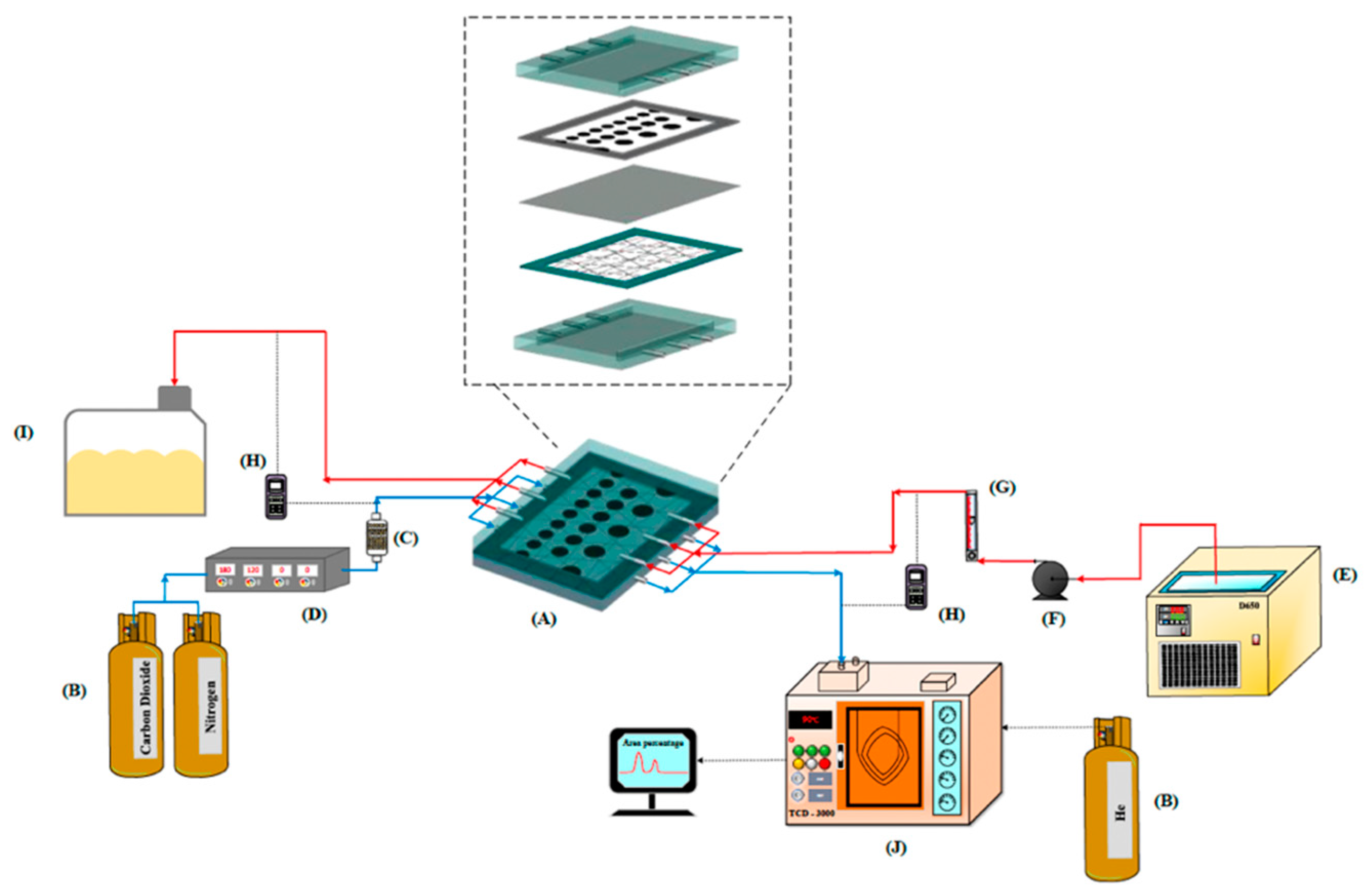
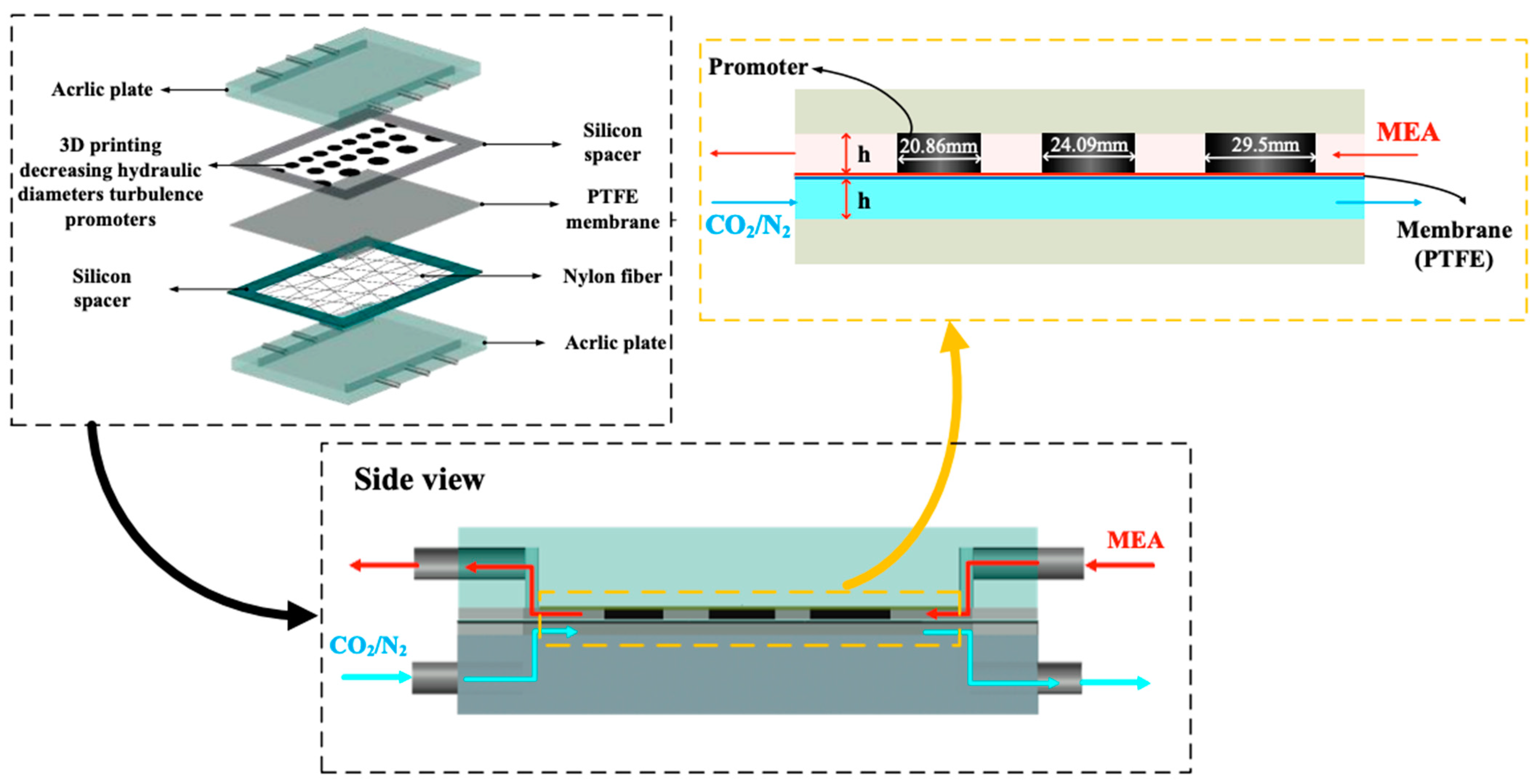
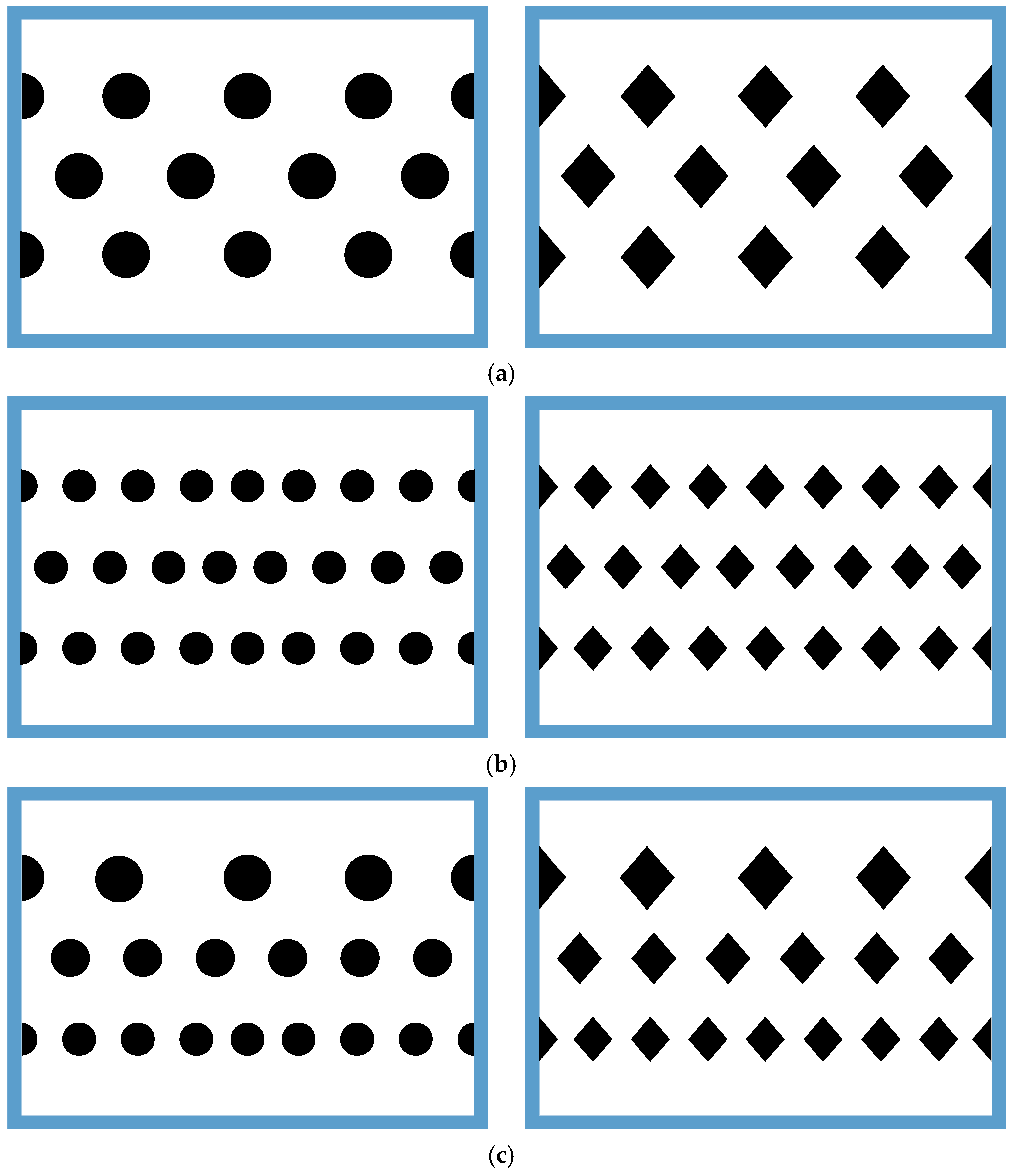
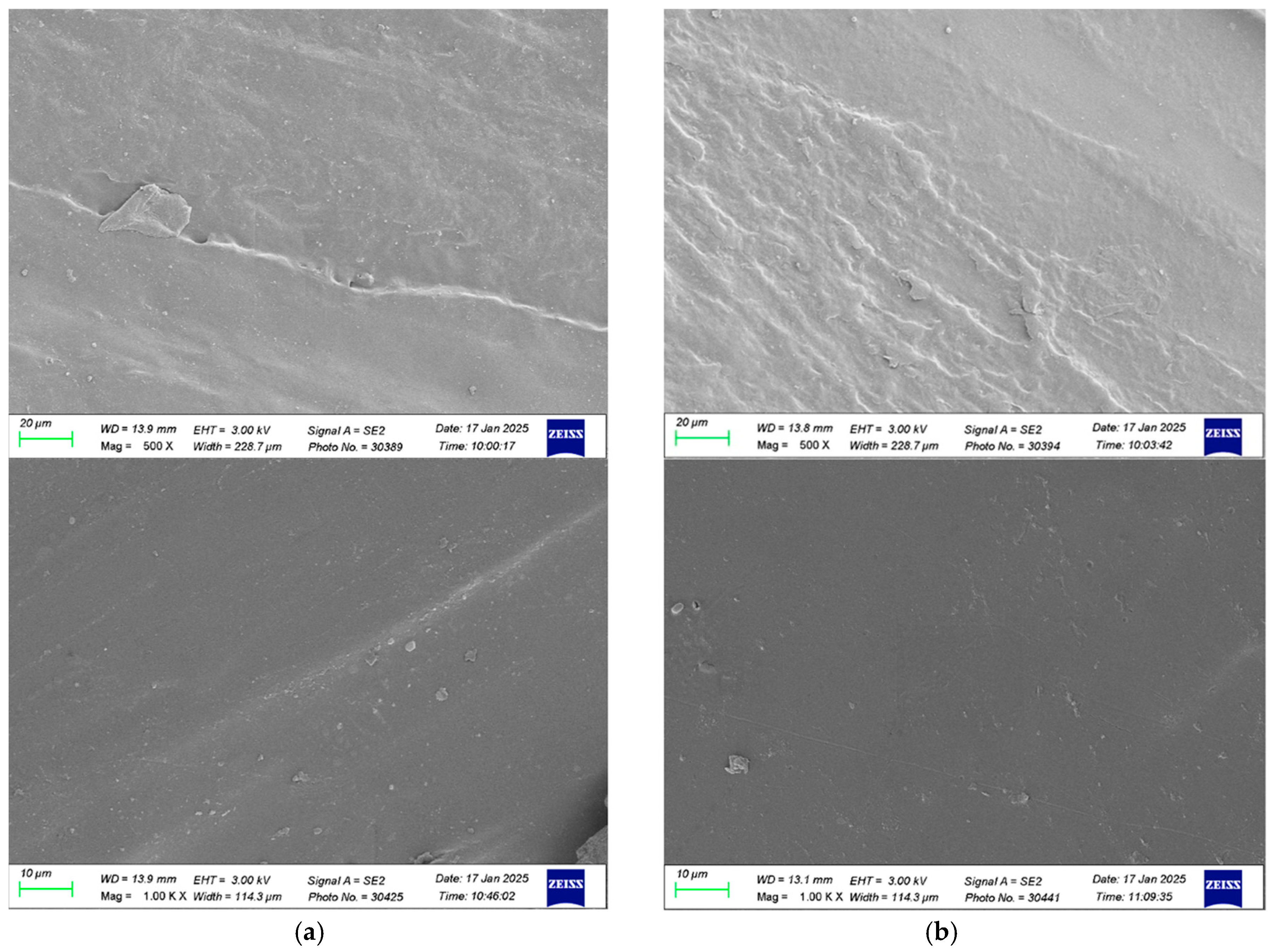
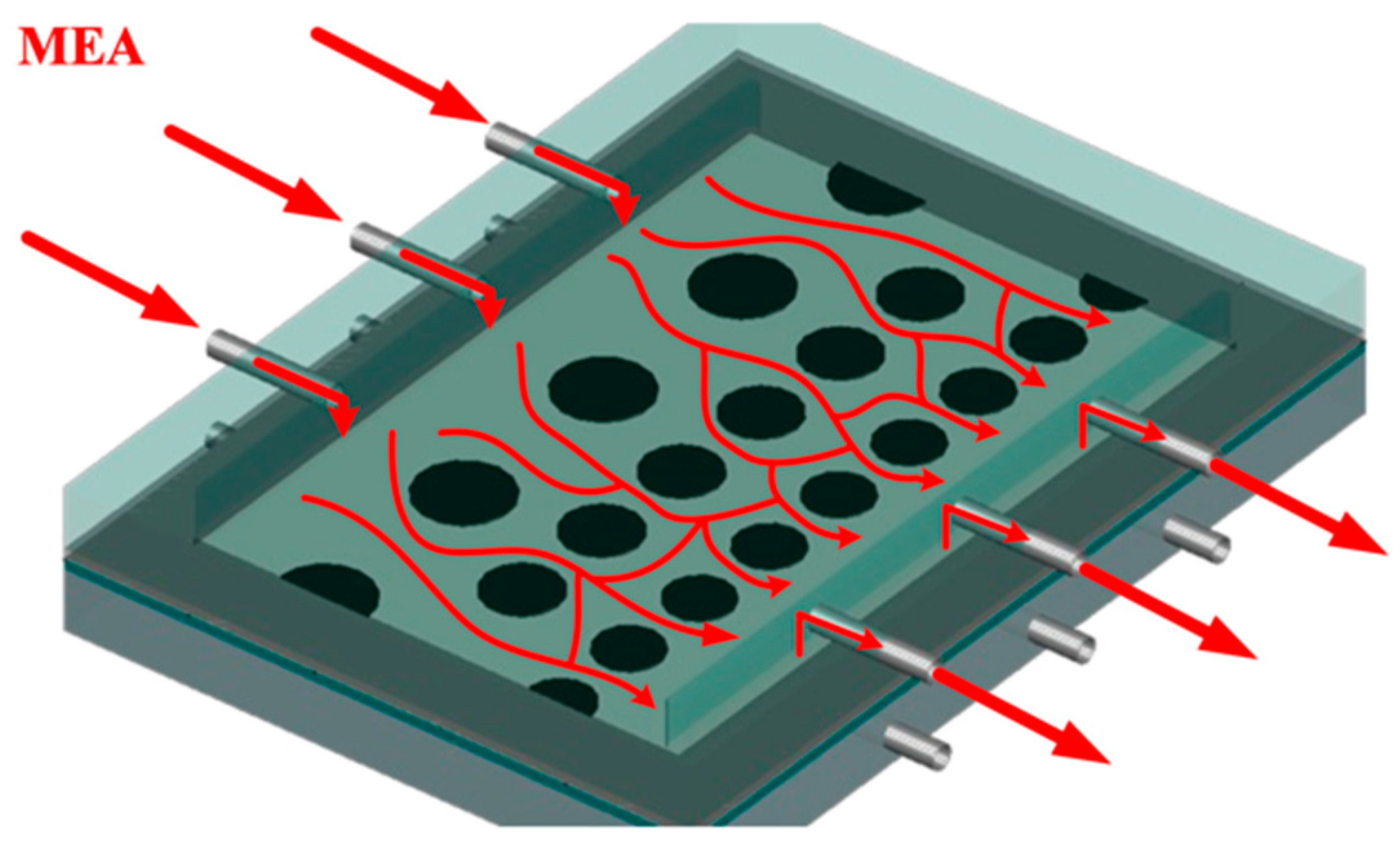
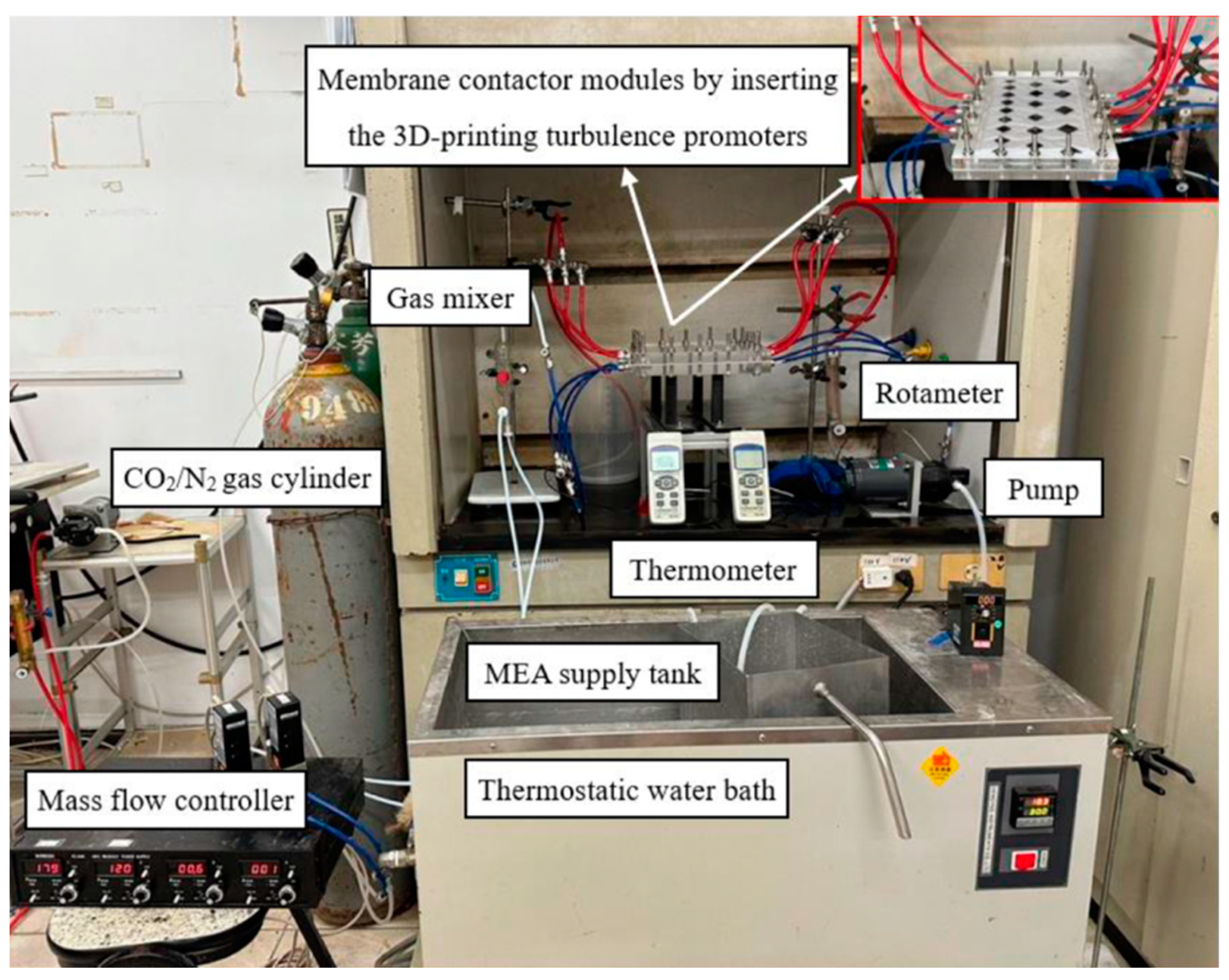

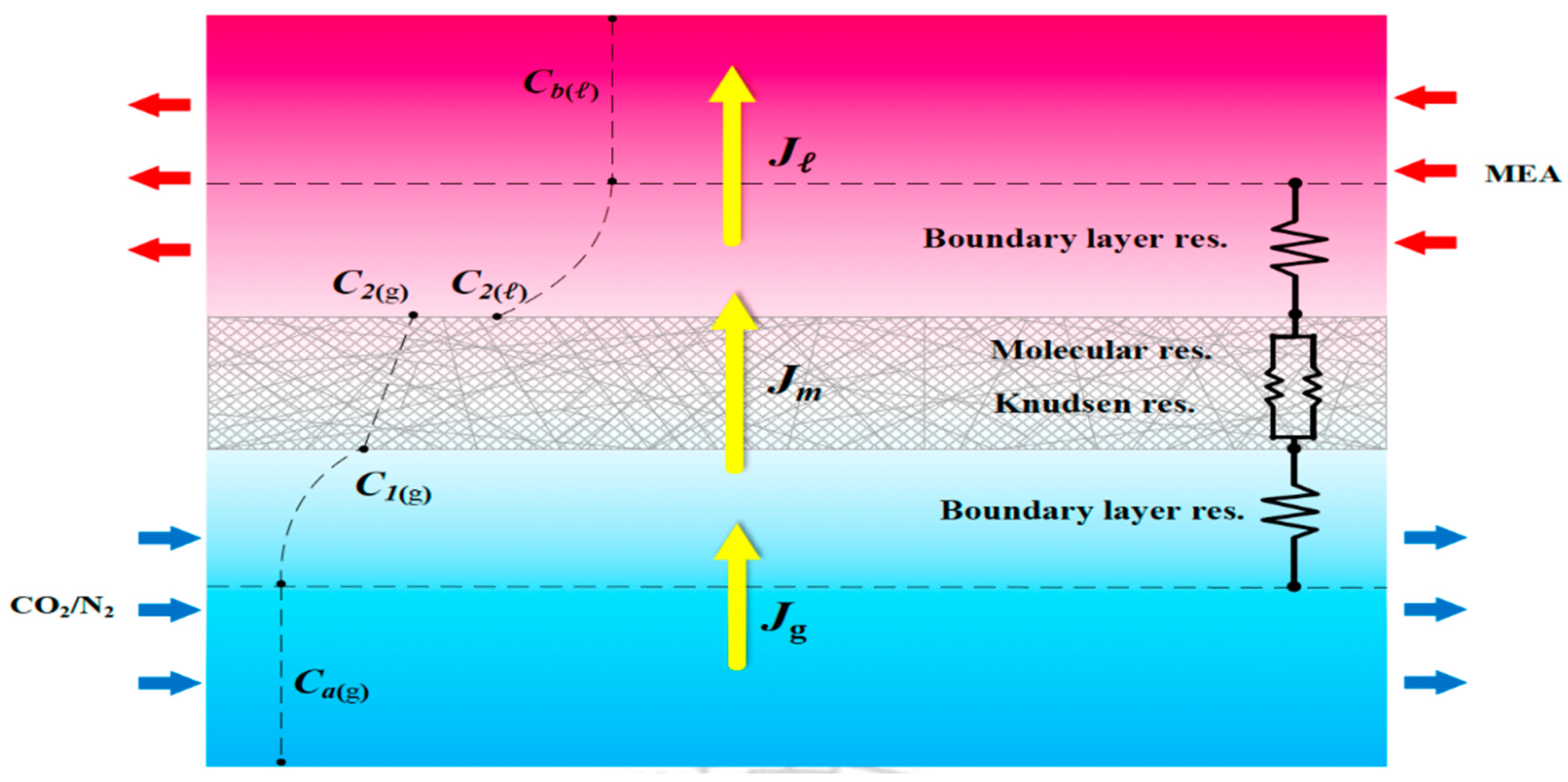
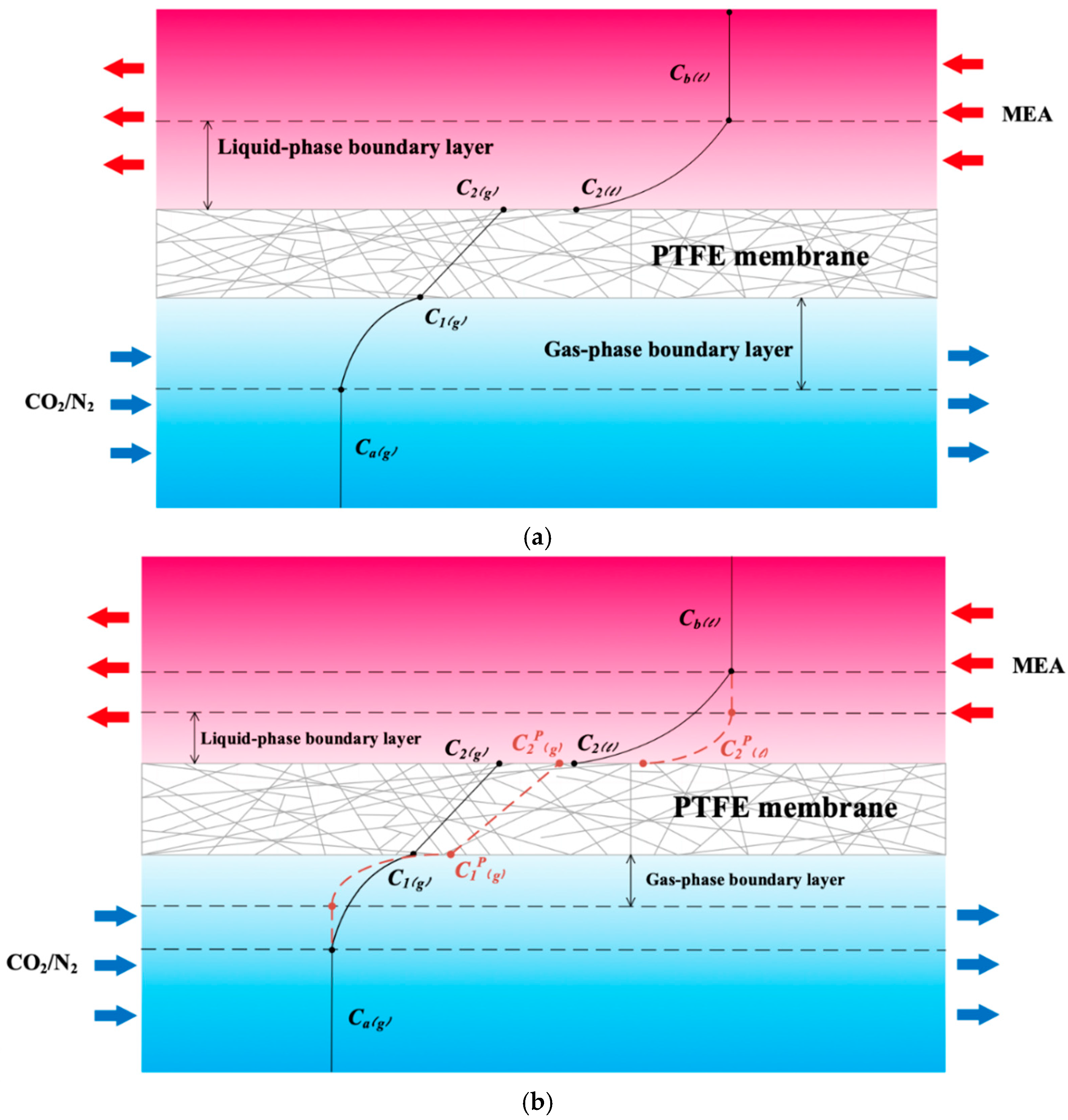
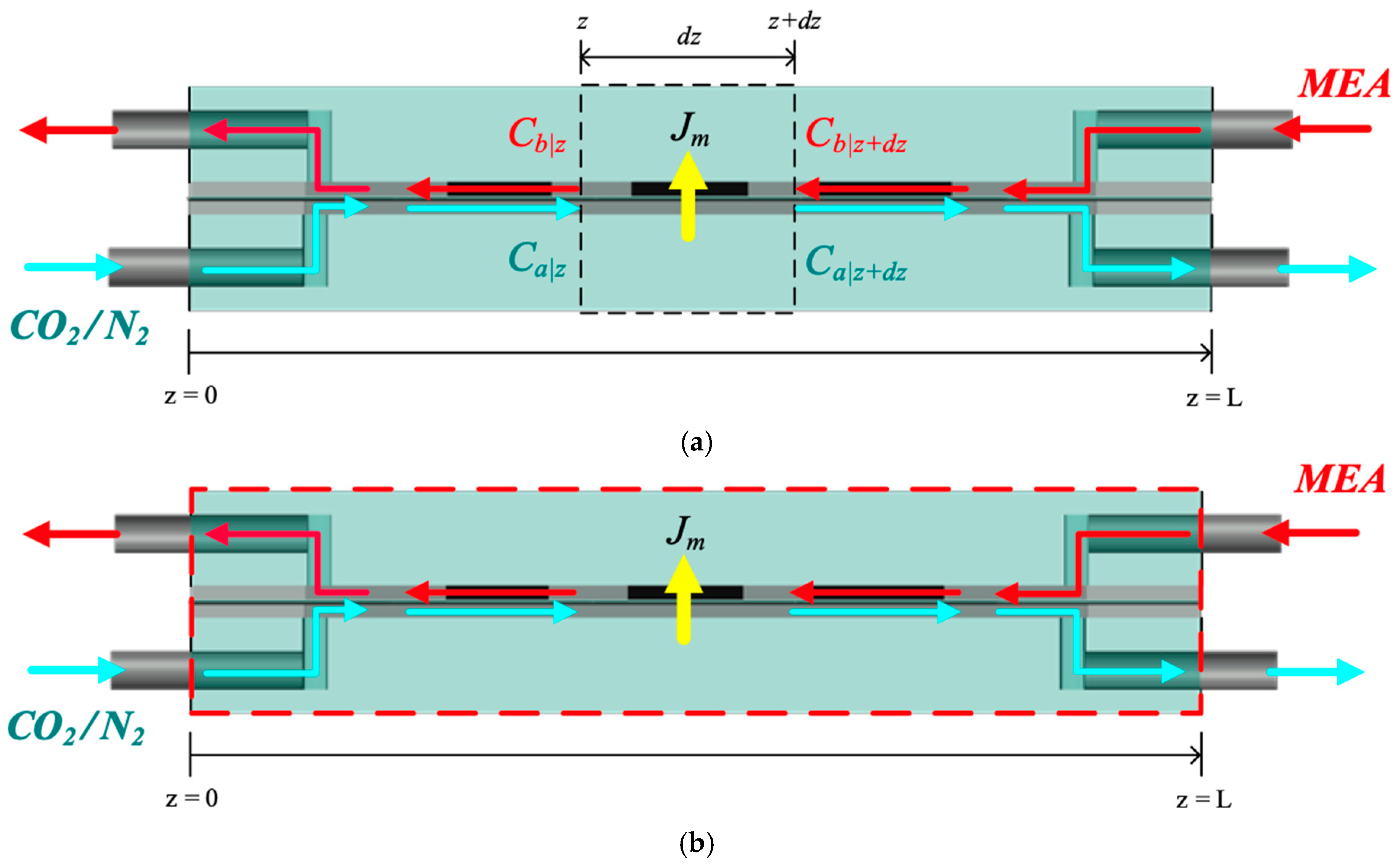
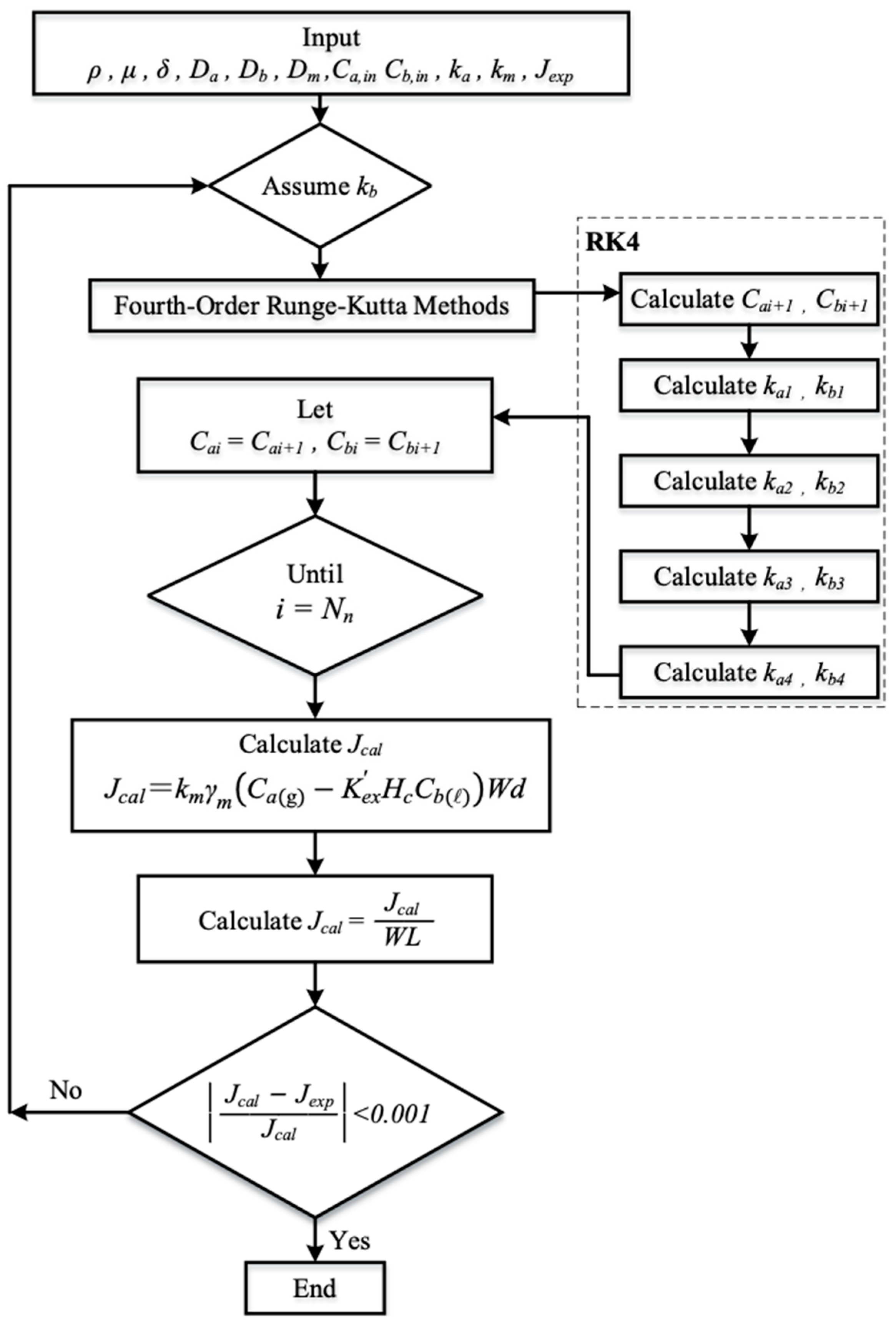
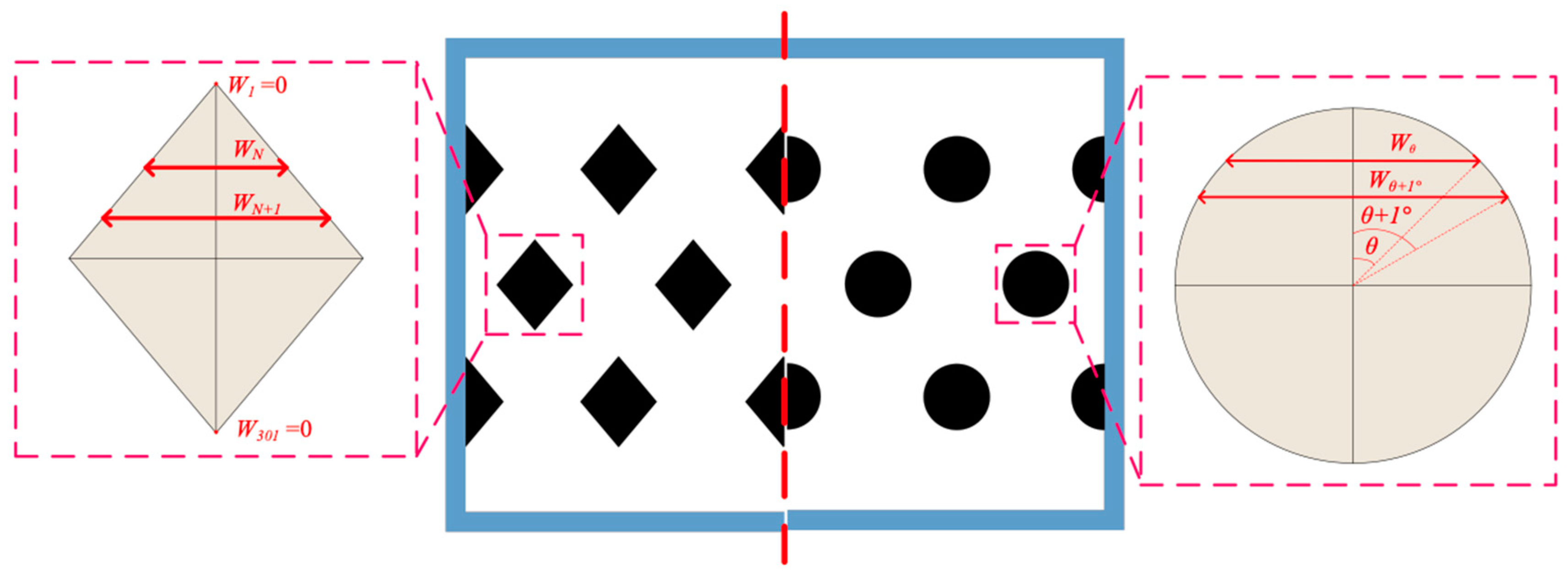
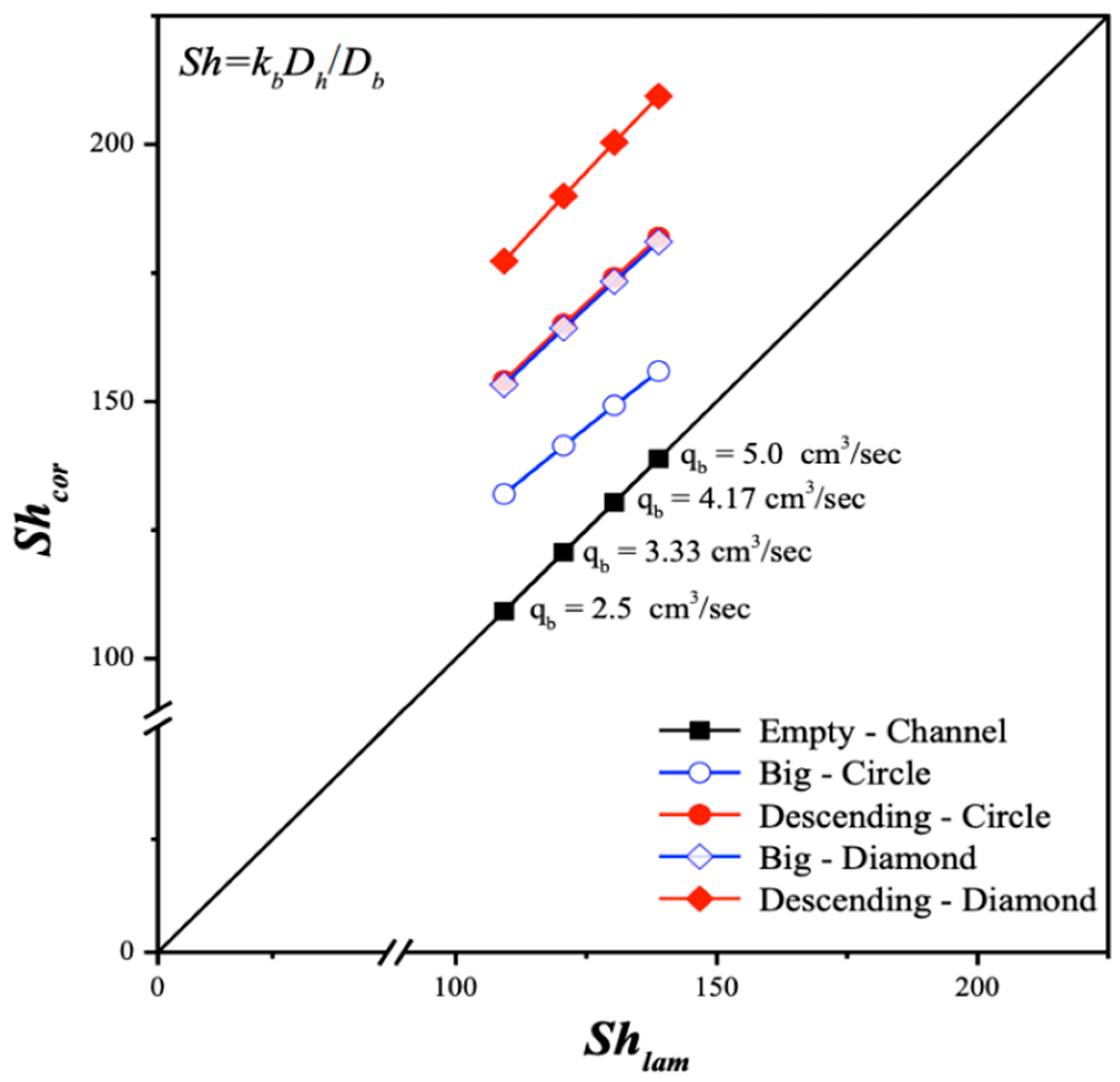
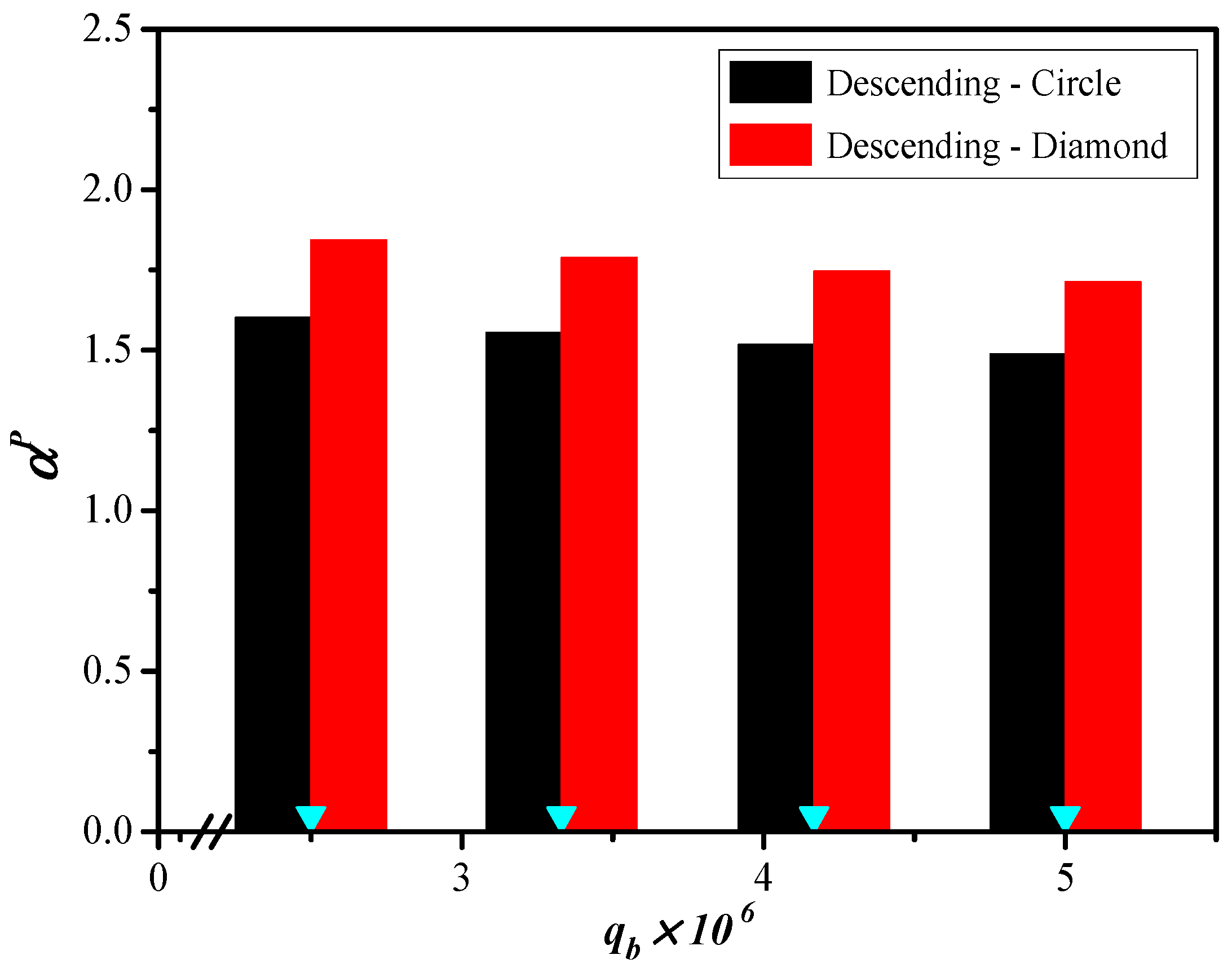
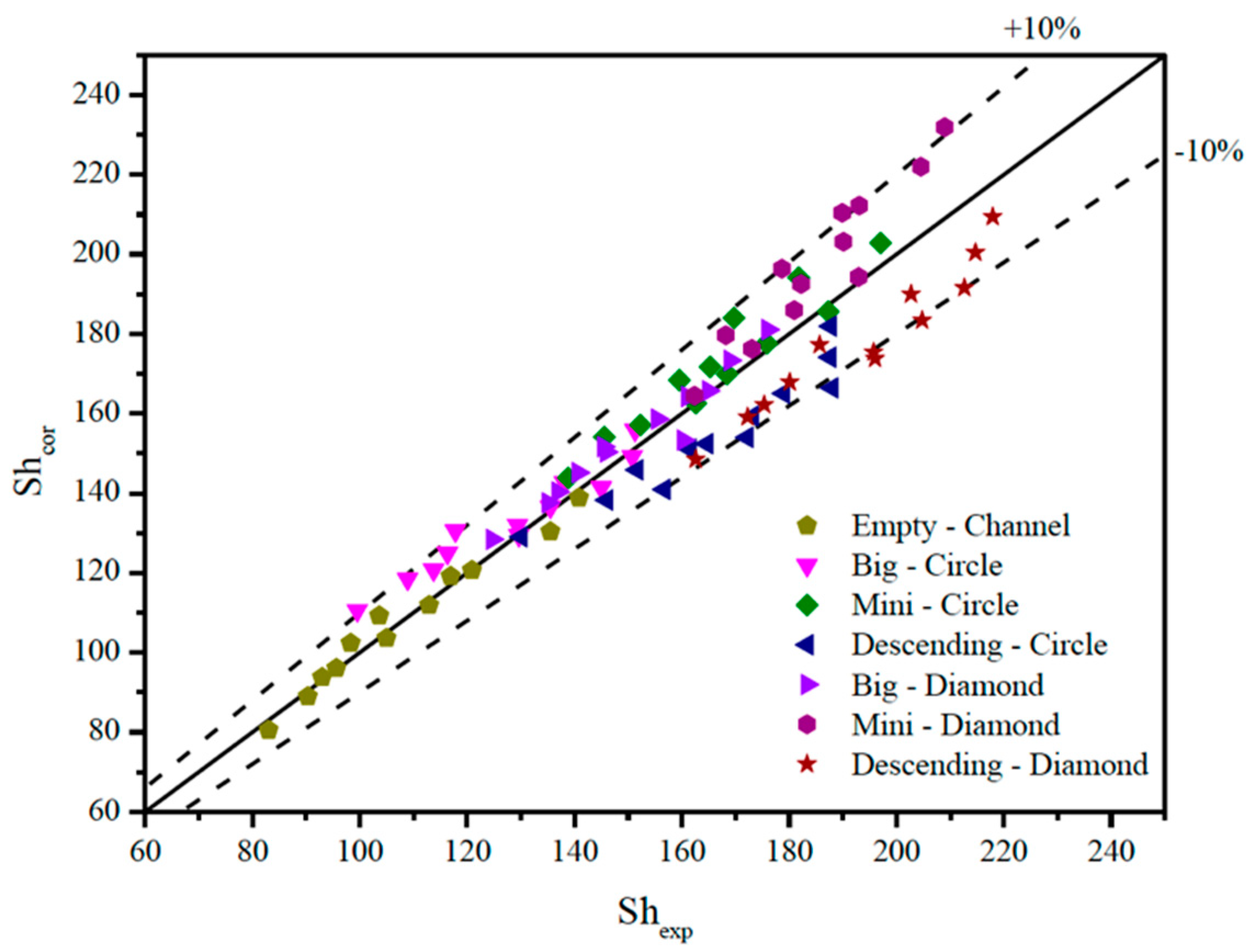
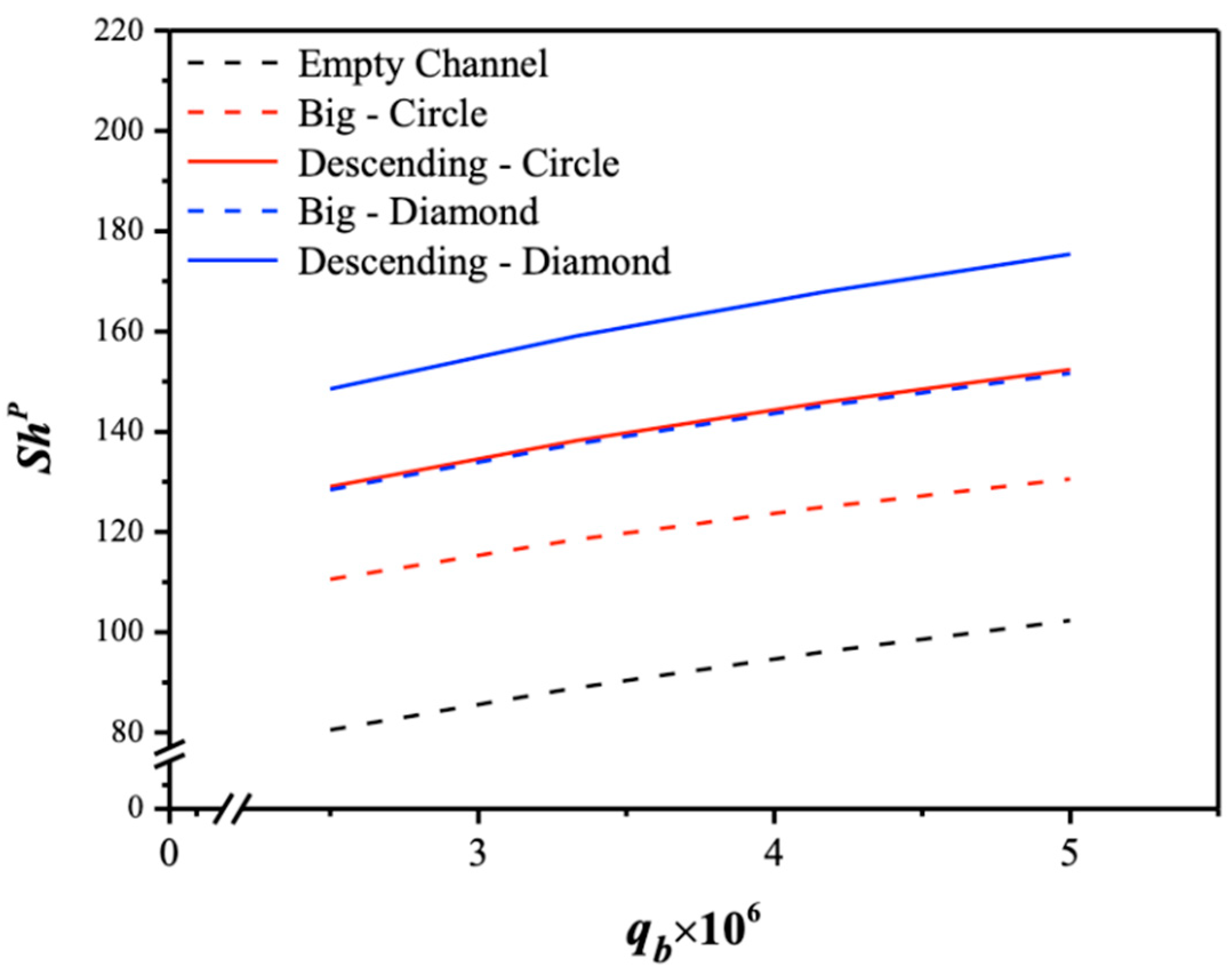
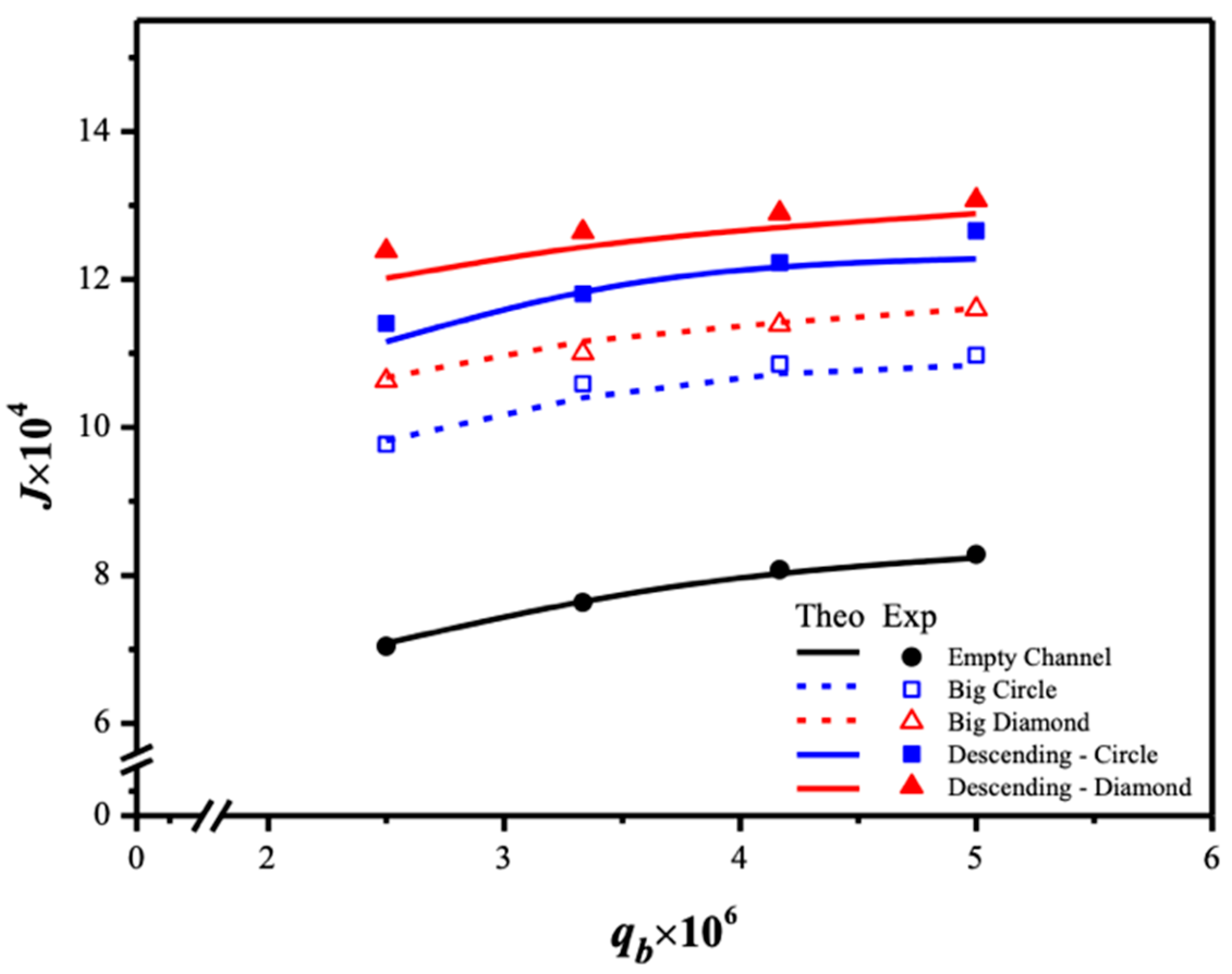
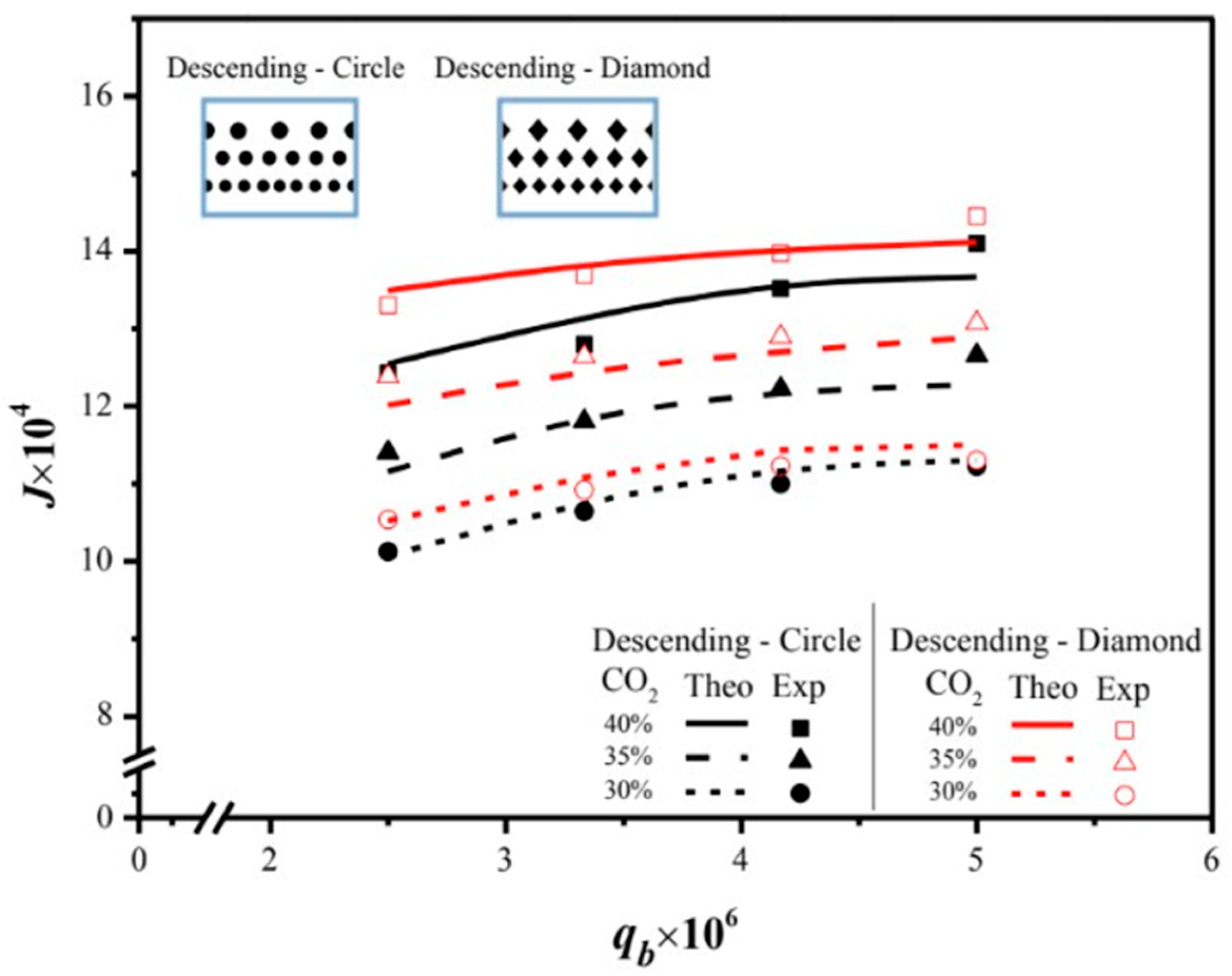
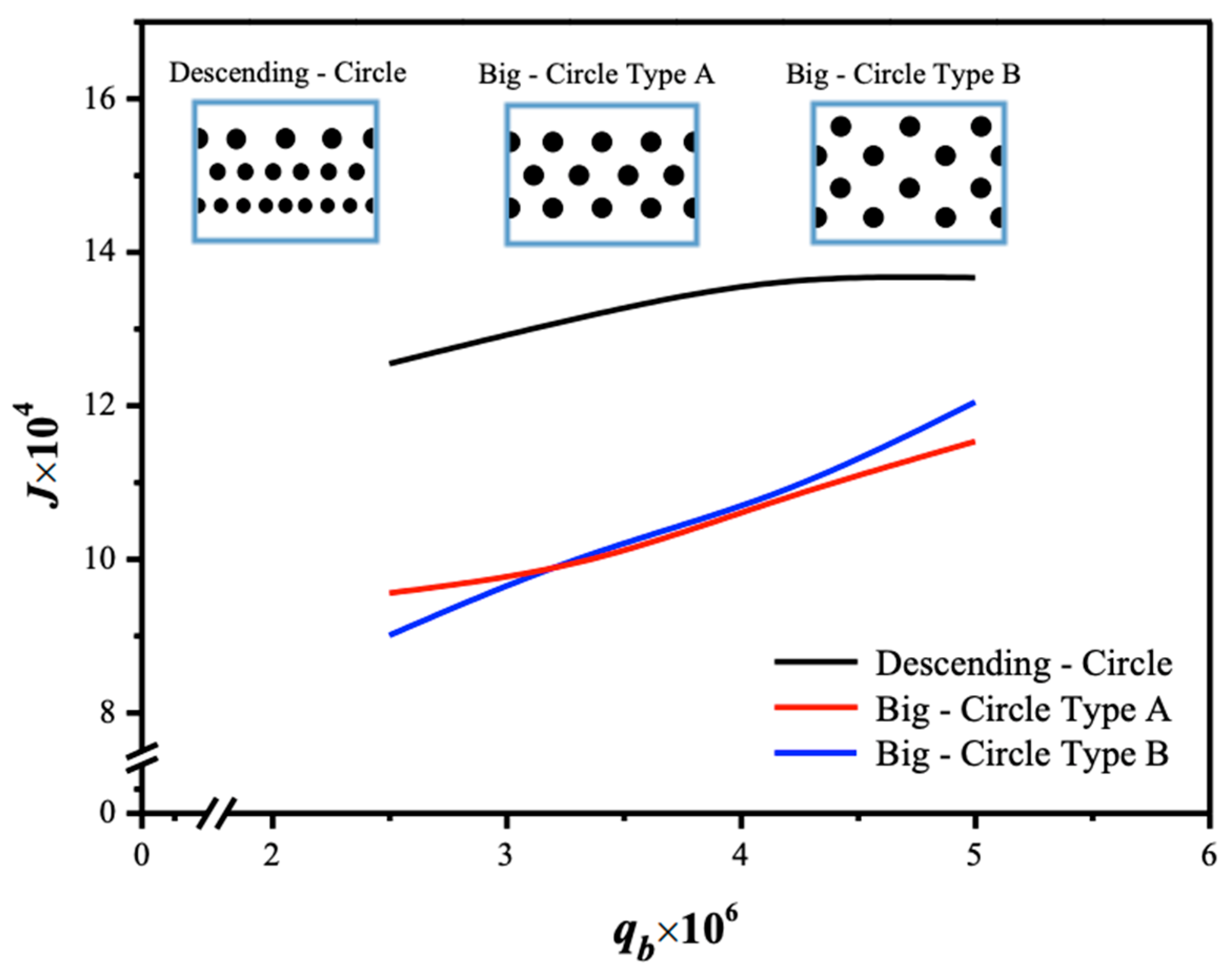
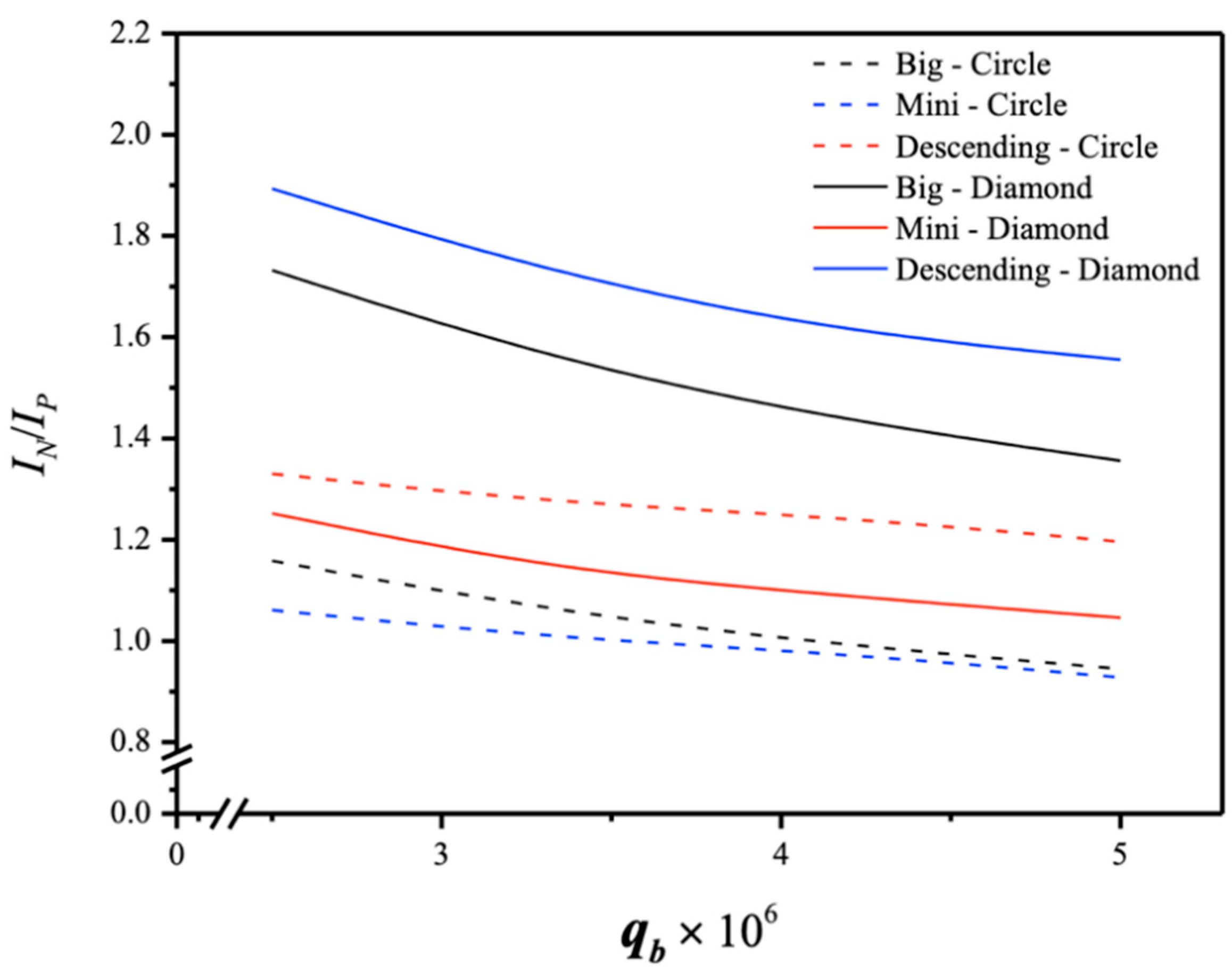
Disclaimer/Publisher’s Note: The statements, opinions and data contained in all publications are solely those of the individual author(s) and contributor(s) and not of MDPI and/or the editor(s). MDPI and/or the editor(s) disclaim responsibility for any injury to people or property resulting from any ideas, methods, instructions or products referred to in the content. |
© 2025 by the authors. Licensee MDPI, Basel, Switzerland. This article is an open access article distributed under the terms and conditions of the Creative Commons Attribution (CC BY) license (https://creativecommons.org/licenses/by/4.0/).
Share and Cite
Ho, C.-D.; Wang, Y.-W.; Chen, Z.-Z.; Chew, T.L. Analysis of CO2 Absorption in Gas/Liquid Membrane Contactors with Inserted Descending Hydraulic Diameters of 3D-Printed Turbulence Promoters. Membranes 2025, 15, 88. https://doi.org/10.3390/membranes15030088
Ho C-D, Wang Y-W, Chen Z-Z, Chew TL. Analysis of CO2 Absorption in Gas/Liquid Membrane Contactors with Inserted Descending Hydraulic Diameters of 3D-Printed Turbulence Promoters. Membranes. 2025; 15(3):88. https://doi.org/10.3390/membranes15030088
Chicago/Turabian StyleHo, Chii-Dong, Yi-Wun Wang, Zheng-Zhong Chen, and Thiam Leng Chew. 2025. "Analysis of CO2 Absorption in Gas/Liquid Membrane Contactors with Inserted Descending Hydraulic Diameters of 3D-Printed Turbulence Promoters" Membranes 15, no. 3: 88. https://doi.org/10.3390/membranes15030088
APA StyleHo, C.-D., Wang, Y.-W., Chen, Z.-Z., & Chew, T. L. (2025). Analysis of CO2 Absorption in Gas/Liquid Membrane Contactors with Inserted Descending Hydraulic Diameters of 3D-Printed Turbulence Promoters. Membranes, 15(3), 88. https://doi.org/10.3390/membranes15030088






